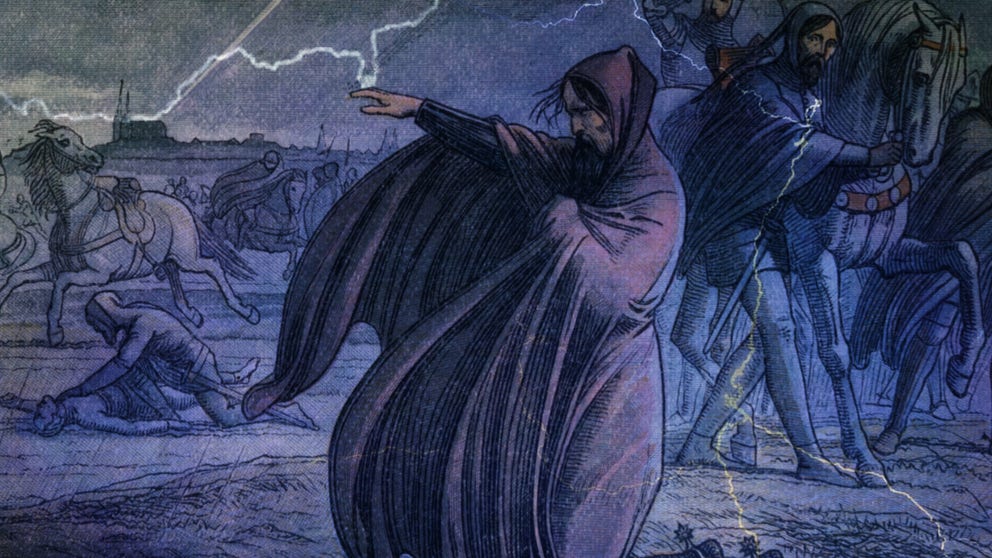7 times weather impacted the outcome of war
When weather and war interact, it can lead to unexpected and seemingly miraculous events
7 times the weather influenced the outcome of war
When weather and war interact, it can lead to unexpected and seemingly miraculous events.
Throughout history, humans have been plagued by war and inclement weather. Occasionally the two forces interact, leading to unexpected and seemingly miraculous events.
Here are seven times war was affected by the weather.
Napoleon’s invasion of Russia
June 1812 – December 1812
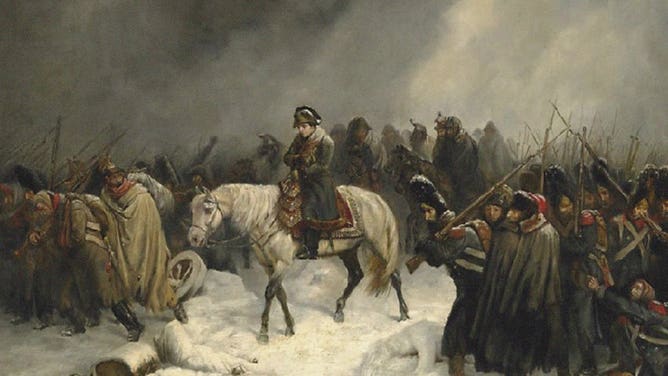
Napoleon's withdrawal from Russia after a failed invasion.
(Fine Art Images/Heritage Images / Getty Images)
In 1812, Napoleon decided it was time to expand his French empire eastward. He amassed a multi-national army and led them across the Neman River, kicking off what would be a six-month invasion of Russia.
Advisors warned Napoleon that Russia would meet his Grande Armée with hostile terrain and inhospitable weather. Napoleon assured them that the invasion would be complete before the Russian winter took hold.
He was wrong.
The Russians refused to engage with Napoleon’s forces. Instead, they performed a series of tactical retreats farther and farther into the Russian interior. As they retreated, the Russians would lay waste to any supplies, preventing the Grande Armée from collecting resources as they marched.
The Grande Armée’s supply lines were inadequate to sustain such a large attacking force, and thousands of Napoleon’s forces fell victim to disease and malnourishment.
Napoleon was able to occupy Moscow on September 14, but his Grande Armée was now a quarter of the size. In the abandoned cultural capital of Russia, Napoleon waited five weeks for a peace offer that would never arrive.
With the brutal Russian winter approaching and his soldiers still in their summer uniforms, Napoleon left Moscow and began his retreat out of the country.
Lack of food and winter clothing coupled with typhus doomed much of the Grande Armée to perish before returning to France. On December 4, Napoleon abandoned his army that had now deteriorated into a disillusioned mob.
Russia’s war of attrition aided by its hostile climate had taken its toll on a once "Grande" invasion force.
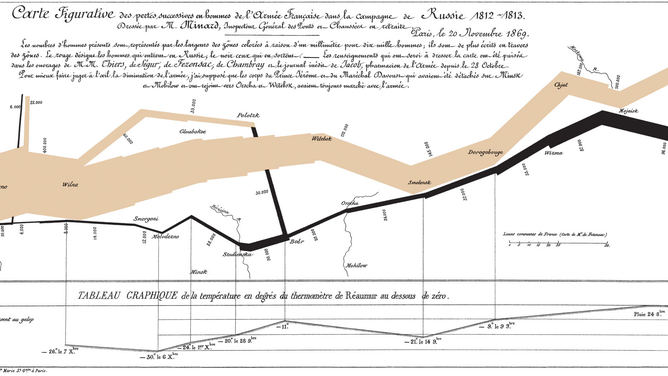
Charles Minard's 1869 chart showing the number of men in Napoleon’s 1812 Russian campaign army, their movements, as well as the temperature they encountered on the return path.
Hitler’s invasion of the Soviet Union
June 1941 – December 1941
Nearly to the day 129 years later, Hitler’s German army would begin a similar invasion of Russia; now the Soviet Union.
Having already had significant success on the western front, the Nazis turned their attention to the east. The objective was to eliminate the Soviet Union from the conflict quickly.
The Soviets were caught off guard by the invasion allowing the Wehrmacht to move swiftly through the western parts of the Soviet Union. The Nazis pushed through the Baltic states, occupied critical economic areas in Ukraine, and reached the outskirts of Moscow by the end of September.
However, as the weather grew chillier, the German offensive began to stall.
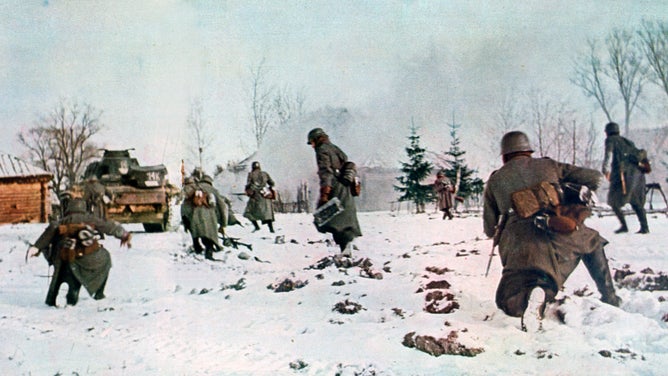
German infantrymen following a tank towards Moscow in the snow, Russia, 1941.
(Photo by Art Media/Print Collector / Getty Images)
The German tanks were slowed by October rains and snows, turning the unpaved Russian roads into mud. Only one out of every 10 German tanks survived the Russian autumn quagmire. The operation had to pause for two weeks to reorganize and wait for the ground to freeze.
By the time the Nazi forces got within striking distance of Moscow, the first of that winter’s blizzards had begun. The Wehrmacht, much like Napoleon’s Grande Armée, was not equipped for such a brutal winter.
Panzer tanks froze. Soldiers were frost-bitten.
When the Nazis were just nine miles from the Soviet capital, the temperature suddenly dropped to -30ºF. The sudden cold snap coincided with a Soviet counterattack. German troops, paralyzed by cold, could not properly aim their weapons. Even when they did aim them, they were often encrusted with ice causing their bolt mechanisms to shatter or recoil liquid to freeze. Mortar shells detonated in deep snow with a gentle thud.
The formidable Wehrmacht invasion was frozen, and the Nazis could not take the Soviet capital. The opening of the eastern theater and the inability of Germany to quickly remove the Soviet Union from the conflict turned the tide of the entire war.
‘WEATHER IS CLEARLY A FACTOR’ IN RUSSIA-UKRAINE CONFLICT, ANALYST SAYS
Nagasaki instead of Kokura
Aug. 9, 1945
On Aug. 6, the United States dropped an atomic bomb on Hiroshima, Japan.
Three days later, Special Mission 16 lifted off from Tinian Island, with Kokura, Japan, as the target for a second bomb. Maj. Charles W. Sweeney piloted the delivery aircraft "Bockscar" with its payload, "Fat Man." Sweeney had explicit orders to drop the bomb visually and not by radar for this mission.
Visibility was low over Kokura as the aircraft circled above, trying to get a visual of the target. Overcast weather conditions and smoke from nearby firebombings obscured visibility.
Bockscar circled Kokura for 50 minutes, which was long enough for the anti-aircraft fire to begin defending the city and for the American aircraft to use a substantial amount of fuel. Sweeney decided to abandon Kokura and move toward the secondary target: Nagasaki.
Visibility over Nagasaki wasn’t much clearer, but at 11:01 a.m., a break in the cloud cover allowed Bockscar’s bombardier, Capt. Kermit Beahan, to see the target.
Forty-seven seconds later, the bomb detonated over Nagasaki, Japan, devastating the city and bringing World War II to a close.
Kokura, a city of 130,000 people, was spared by a cloudy day.
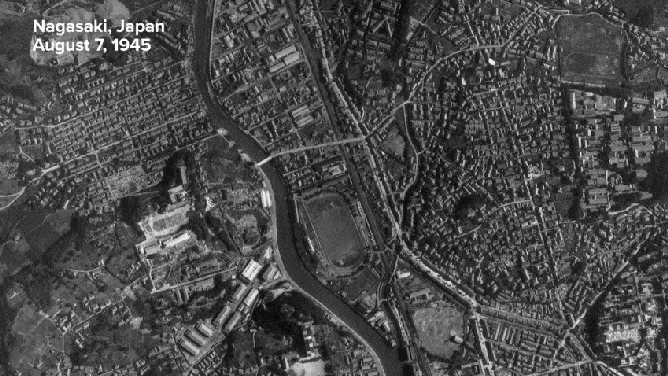
Aerial photographs of Nagasaki, Japan before and after the August 9th bombing.
(Getty Images)
Destruction of the Spanish Armada
August 1588
While at war with England, King Philip II, of Spain, spent two years building and preparing a large fleet to compete with the British Navy. In 1588, the Spanish Armada sailed, ready to invade London and devastate the English.
The Armada planned to provide cover to the Spanish army while ferrying across the English Channel to begin a ground offensive on London. The Spanish dropped anchor on the coast of France on Aug. 6. From there, they hoped to rendezvous with their ground troops for the remainder of their mission.
While the Spanish ships were anchored, the British set eight of their unoccupied vessels on fire. The wind and tide did the rest of the work.
The flaming ships approached the Spanish Armada scattering its ships away from the coast of France and into the open sea.
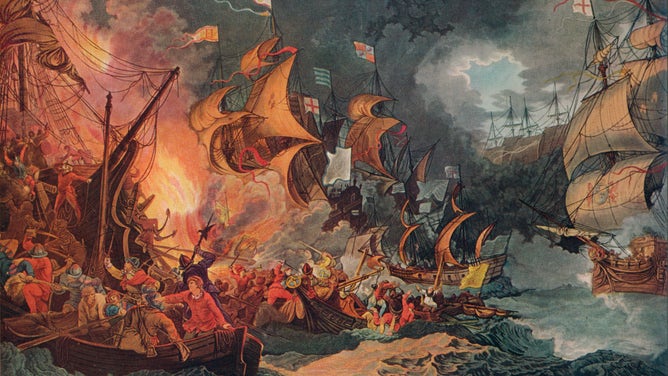
The defeat of the Spanish Armada (c1797), from 'Old Naval Prints,' by Charles N Robinson.
(Photo by Print Collector / Getty Images)
The British fleet attacked with the Spanish fleet in disarray, destroying at least four Armada ships. The Spanish Armada retreated by fleeing farther into the open ocean.
Strong winds carried the remaining ships into the North Sea. North Atlantic storms pounded the ships into oblivion as they tried to swing around Ireland and back to Spain. When the once-mighty fleet arrived back in Spain, it was half its original size.
The English emerged from the conflict as one of the world’s most feared sea powers. However, the power of the sea’s storms deserves partial credit for the resounding victory.
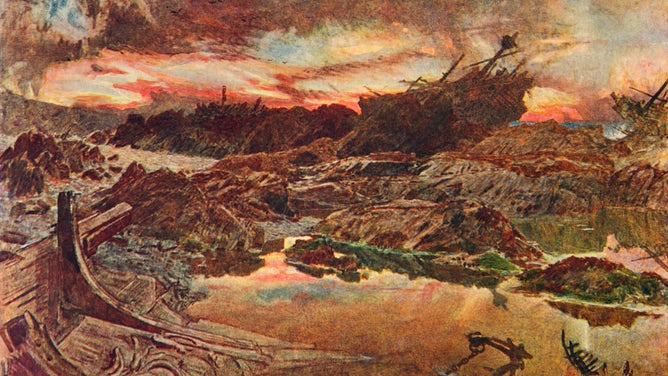
The Spanish Armada was ravaged by North Atlantic storms, and many ships ran aground in Ireland and Scotland.
(Print Collector / Getty Images)
Escape from Long Island
August 1776
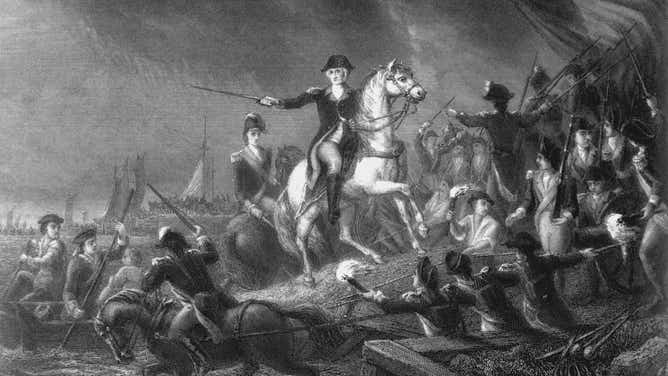
Washington's retreat at Long Island
(Photo by Interim Archives / Getty Images)
The early stages of the American Revolutionary War were difficult and consisted of many retreats by the Continental Army. The Battle of Long Island, sometimes referred to as the Battle of Brooklyn, was no exception.
After several days of intense battle, the British cornered Washington and his 9,000 troops in Brooklyn Heights with their backs to the East River. The colonial troops needed to cross the East River into Manhattan without being detected. An inconspicuous exit seemed impossible with the British forces surrounding the colonial encampment.
Fortunately, a dense fog had taken hold over the river.
The fog allowed Washington and all 9,000 troops to escape into Manhattan without any casualties. When the sun rose, the British moved in, stunned to find that the Continental Army had vanished.
The midnight escape in Brooklyn Heights preserved the perilous American war effort. It also showed both sides that there would be no easy victory in this conflict.
Battle of the Bulge
December 1944 – January 1945
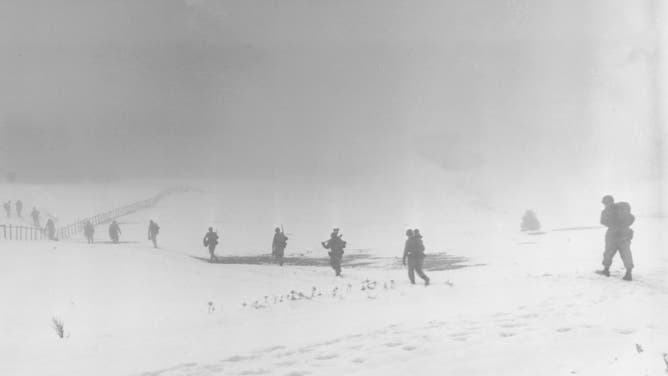
A photograph of soldiers of an Infantry Division moving into the mist toward their objective over a snow-covered field near Krinkelter, Belgium, December 20, 1944.
(Fotosearch / Getty Images)
In December 1944, the Germans launched a surprise offensive in the Ardennes region between Belgium and Luxembourg.
In the opening stages of the battle, the weather gave the Germans the upper hand. The frigid temperatures and blizzard conditions kept the Allies’ superior air attack on the ground. A fierce ground defense, particularly from American forces, notably around Elsenborn Ridge, prevented the Nazis from accessing critical roads to the northwest and west. Troops braved near-arctic conditions, and many who were wounded froze to death before being rescued.
The Germans continued advancing despite this fierce defense as the inclement weather persisted. On Dec. 23, the weather cleared up, and the Allies were able to run bombing raids on the Nazi supply lines with their aircraft.
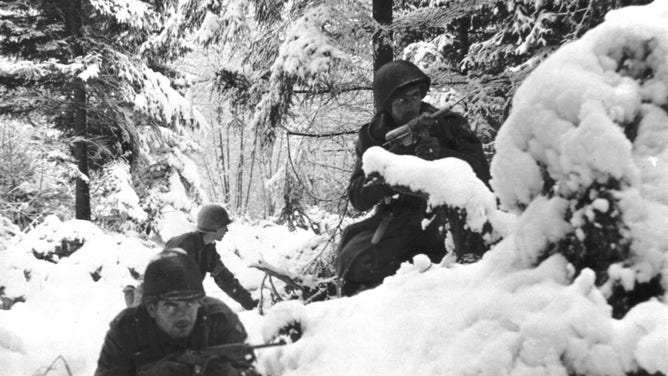
During the Battle of the Bulge, infantrymen of the 7th US Infantry Division dig in for an attack in snowdrifts near Amonies (Belgium) on January 4, 1945.
(Photo12/UIG / Getty Images)
As the weather turned, so did the tide of the battle. Now cut off from their supply lines, the Germans stopped advancing on Dec. 27. The battle continued for several more weeks as the Allies pushed the Nazis back to where they had been before launching their attack.
The Battle of the Bulge was the bloodiest single battle fought by the United States during World War II.
It was the last offensive attempt by the Axis Powers during World War II.
Tornado saves Washington
Aug. 24, 1814
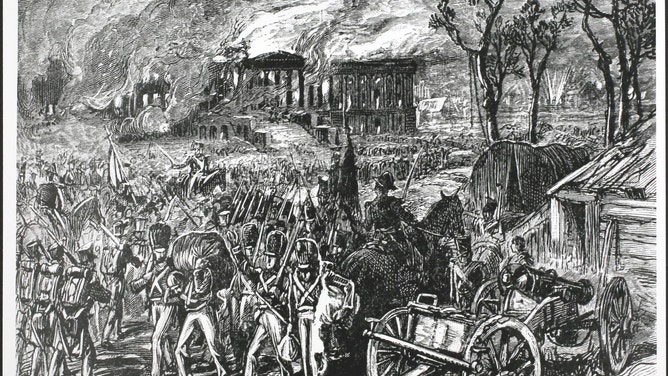
Capture and burning of Washington by the British in 1814.
(Hulton Archive / Getty Images)
During the War of 1812, British troops staged a successful invasion of Washington City (now Washington, D.C.).
British soldiers torched many government buildings in the city, including the White House and the Capitol building. During this incident, first lady Dolley Madison famously saved a portrait of George Washington from going up in flames. President James Madison and members of the government were able to evacuate to Montgomery County, Maryland.
The fires continued to rage throughout the city as the British occupied the American capital. Then, Mother Nature got in on the action.
Severe thunderstorms began drenching the burning city. At least one tornado passed through the capital’s center. The rain extinguished the flames and severely damaged several British ships. After 26 hours of occupation, the British retreated out of the city.
This sudden thunderstorm that coincided with the city’s occupation has since been called the "Storm that saved Washington." Though it extinguished the flames, it also exacerbated some damage created by the Americans’ foes. For instance, despite being spared by the Brits, the Patent Office lost its roof to the high winds.
By the end of the invasion and subsequent storm, inclement weather had killed more British soldiers than American guns.
Black Monday: How a deadly freak hailstorm stopped a medieval war
On April 13, 1360, a deadly freak hailstorm convinced King Edward III to seek a peace treaty with France during the Hundred Years' War.

